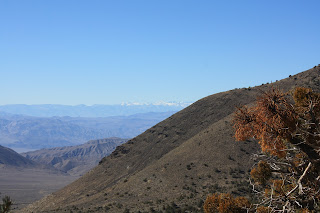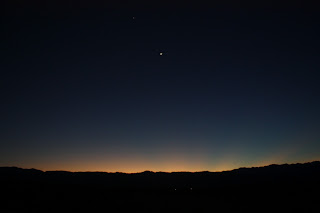After an early breakfast near our motel in Lone Pine, we drove nearly two hours to reach our major hike of the day. As we came down out of the Inyo Mountains, we stopped off at Father Crowley Overlook Point we got our first look at the Panamint Valley (and the Panamint Range beyond) down a broad canyon
Then another long drive took us down into the Panamint Valley and across to the foothills of the Panamint Range. Our plan was to head for Wildrose Peak, which was recommended as a possible mountain hike until Telescope Peak is free of snow; at its 11000 foot elevation, that mountain is usually not hikeable until May.
We paused at the trailhead to look at a set of eight kilns for making charcoal for use in a 19th century mine
then hiked upward. Sadly, although our destination was clear of snow, much of the trail at the lower elevations was covered with snow, which had iced up from being crossed by hikers on other days. It made the hike up tough going.
More than that, I found myself out of breath from a combination of the elevation and being out of shape, having just recovered from a broken foot. I felt lucky to have recovered in time for our desert vacation; but in the end, a few weeks of regular soccer and just plain walking to and from work every day would have left me better prepared for this hike.
As we hiked upward, we looked over toward Telescope Peak, which although not completely covered with snow after a relatively dry winter, was still showing a fair amount of snow on the ground between the trees.
As we reached the crest of the first set of ridges, we took in the marvelous views down into Death Valley and across to the Amargosa Range,
and back across Panamint Valley with the Sierra Nevadas in the distance.
We stopped at a saddle maybe 500 to 700 feet of elevation short of our destination, which was sufficiently snow-free that we could have made it had we been willing to spend our entire day on this hike.
But we wanted to see other sights as well, so we stopped for a nice midday snack of fruit, nuts, cheese cookies left over from our Valentine’s Day open house; the view from our perch was nice.
Next, we drove across the Panamint Range through Emigrant Canyon
to reach our next destination: Mosaic Canyon, just before the small village of Stovepipe Wells.
This began as a narrow canyon, with the walls so close that we could barely walk through.
But after the first several hundred yards, the canyon broadened and we were able to sit down for a lunch of leftovers from our Thursday lunch and dinner, without having to worry about blocking the way of other tourists.
Then we walked another mile up the canyon, up a series of dry waterfalls until we found our way blocked by a high falls.
We could have taken a route around to the left, but the shadows were already gathering on the canyon walls,
and we wanted to move onto to the spot we had selected for watching the sunset.
As we drove back to the valley from Mosaic Canyon, we could see that destination – the Mesquite Flats sand dunes
This sunset experience had been recommended by Eric Goldman, a colleague whose experiences in Death Valley a dozen years earlier had formed one of my basic guides in planning this vacation. (The AAA Death Valley Guide Map was also invaluable). As we drove up, there were about a dozen other cars in the parking lot, but the dunes were extensive enough that we found a set of dunes for ourselves,
and felt pretty much out on our own as the sunset grew brilliant, and the dusk gathered.
We stayed until the light was gone, and only the fairly new moon and a couple of planets were visible in the sky.
We drove back into Stovepipe Wells and had an adequate dinner at the Toll Road Restaurant in the hotel complex. The ancho flavored shrimp with linguine was tasty; there weren’t many shrimp, but the dish featured a terrific medley of vegetables (spinach, cherry tomatoes, and peppers) and again the portions were too large to finish at dinner; the leftovers made a great lunch the next day as we began our drive back to Los Angeles.
It was pitch black as we drove back toward Lone Pine – much of the way was straight, but the twisty roads in some sections seemed more sinister knowing how sheer some of the dropoffs were. We stopped again at the Father Crowley Overlook, this time to look up at the sky. The sky was clear and there wasn’t any ground light for miles around. The sky was brilliant with stars, the Milky Way as full as we had ever seen it. There were so many stars visible in the sky that we couldn’t find many of the familiar constellations. We gazed for several minutes, enjoying the stillness, before we got back into the car to drive back to our motel in Lone Pine.

























No comments:
Post a Comment